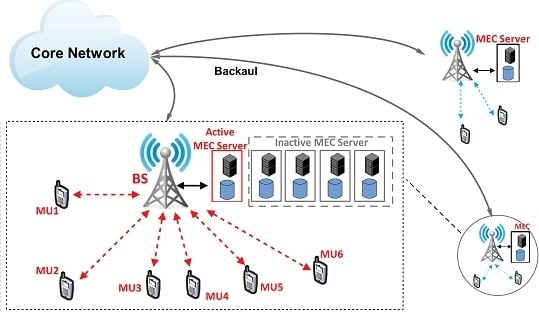Energy-Efficient Caching for Mobile Edge Computing in 5G Networks
Abstract
:1. Introduction
- We make a trade-off between system average download latency (SADL) and system average energy consumption (SAEC) by developing an effective caching placement strategy. Our algorithm achieves a close-to-minimum delay cost to SADL compared to the delay optimal algorithm, while minimize SAEC.
- We indicate the influence of the content popularity distribution satisfying the required number of active MECS, as well as the influence of the backhaul capacities on the required cost of system. Numerical results show that the proposed joint cost optimal (JCO) algorithm outperforms the conventional caching placement strategies achieve a significant performance improvement and effectively reduces system energy consumption.
2. System Model and Problem Formulation
2.1. System Model
2.1.1. Wireless Transmission and Content Caching Model
2.1.2. Users Model
2.1.3. Delay Cost Model
2.1.4. Power Consumption Model
2.2. Problem Formulation
2.2.1. Delay Optimization
2.2.2. Joint Delay Cost with Power Consumption Optimization
| Algorithm 1. Joint Cost Optimal (JCO) algorithm |
| 1: Set , and 2: whlie 3: Calculate ,,,, then set 4: If (6) is satisfied for active a new MECS 5: If (8) is satisfied for inactive a new MECS 6: If then 7: ,and use genetic algorithm minimum 8: else then 9: obtain , 10: update ,and if then reset 11: End If 12: Until , end whlie 13: Output ,,, |
3. Numerical Results
3.1. Impact of the Backhaul Capacities
3.2. Impact of the Content’s Popularity Pattern
3.3. Impact of the Joint System Cost
4. Conclusions
Acknowledgments
Author Contributions
Conflicts of Interest
Abbreviations
| MEC | Mobile Edge Computing |
| MECS | Mobile Edge Computing Server |
| MNOs | Mobile network operators |
| MCS | Mobile communication system |
| MUs | Mobile Users |
| HD | High Definition |
| EE | Energy efficiency |
| BS | Base station |
| OFDMA | Orthogonal Frequency Division Multiple Access |
| SNR | Signal-to-Noise Ratio |
| SADL | System Average Download Latency |
| SAEC | System Average Energy Consumption |
| CN | Core Network |
Appendix A
Appendix B
References
- Paschos, G.; Bastug, E.; Land, I.; Caire, G.; Debba, M. Wireless caching: Technical misconceptions and business barriers. IEEE Commun. Mag. 2016, 54, 16–22. [Google Scholar] [CrossRef]
- Cisco CVNI. Global Mobile Data Traffic Forecast Update, 2015–2020 White Paper. Document ID: 1465272001663118. Available online: http://www.cisco.com/c/en/us/solutions/collateral/service-provider/visual-networking-index-vni/ (accessed on 1 June 2016).
- Li, C.; Zhang, J.; Letaief, K.B. Throughput and energy efficiency analysis of small cell networks with multi-antenna base stations. IEEE Trans. Wirel. Commun. 2014, 13, 2505–2517. [Google Scholar]
- Hu, Y.C.; Patel, M.; Sabella, D.; Sprecher, N.; Young, V. Mobile edge computing-A key technology towards 5G. In ETSI White Paper; ETSI: Antipolis, France, 2015. [Google Scholar]
- Roman, R.; Lopez, J.; Mambo, M. Mobile edge computing, Fog et al.: A survey and analysis of security threats and challenges. Future Gener. Comput. Syst. 2016. [Google Scholar] [CrossRef]
- Baştuǧ, E.; Bennis, M.; Kountouris, M.; Debbah, M. Cache-enabled small cell networks: Modeling and tradeoffs. EURASIP J. Wirel. Commun. Netw. 2015, 1, 1–11. [Google Scholar]
- Peng, X.; Zhang, J.; Song, S.H. Cache size allocation in backhaul limited wireless networks. In Proceedings of the IEEE International Conference on Communications (ICC), Kuala Lumpur, Malaysia, 23–27 May 2016. [Google Scholar]
- Zeydan, E.; Bastug, E.; Bennis, M.; Kader, M.A. Big data caching for networking: Moving from cloud to edge. IEEE Commun. Mag. 2016, 54, 36–42. [Google Scholar] [CrossRef]
- Zheng, K.; Yang, Z.; Zhang, K.; Chatzimisios, P.; Yang, K.; Xiang, W. Big data-driven optimization for mobile networks toward 5G. IEEE Netw. 2016, 30, 44–51. [Google Scholar] [CrossRef]
- Poularakis, K.; Iosifidis, G.; Tassiulas, L. Approximation algorithms for mobile data caching in small cell networks. IEEE Trans. Commun. 2014, 62, 3665–3677. [Google Scholar] [CrossRef]
- Peng, X.; Shen, J.C.; Zhang, J.; Letaief, K.B. Backhaul-aware caching placement for wireless networks. In Proceedings of the IEEE Global Communications Conference (GLOBECOM), San Diego, CA, USA, 6–10 December 2015. [Google Scholar]
- Maddah-Ali, M.A.; Niesen, U. Decentralized coded caching attains order-optimal memory-rate tradeoff. IEEE/ACM Trans. Netw. 2015, 23, 1029–1040. [Google Scholar] [CrossRef]
- Niesen, U.; Maddah-Ali, M.A. Coded caching with nonuniform demands. Trans. Inform. Theory. 2017, 63, 1146–1158. [Google Scholar] [CrossRef]
- Antonopoulos, A.; Kartsakli, E.; Bousia, A.; Alonso, L.; Verikoukis, C. Energy-efficient infrastructure sharing in multi-operator mobile networks. IEEE Commun. Mag. 2015, 53, 242–249. [Google Scholar] [CrossRef]
- Zhang, H.; Huang, S.; Jiang, C.; Long, K.; Leung, V.C.M.; Poor, H.V. Energy Efficient User Association and Power Allocation in Millimeter Wave Based Ultra Dense Networks with Energy Harvesting Base Stations. IEEE J. Sel. Areas Commun. arXiv 2017. [Google Scholar]
- Zhang, H.; Nie, Y.; Cheng, J.; Leung, V.C.; Nallanathan, A. Sensing time optimization and power control for energy efficient cognitive small cell with imperfect hybrid spectrum sensing. IEEE Trans. Wirel. Commun. 2017, 16, 730–743. [Google Scholar] [CrossRef]
- Bousia, A.; Kartsakli, E.; Antonopoulos, A.; Alonso, L.; Verikoukis, C. Game-theoretic infrastructure sharing in multioperator cellular networks. IEEE Trans. Veh. Technol. 2016, 65, 3326–3341. [Google Scholar] [CrossRef]
- Datsika, E.; Antonopoulos, A.; Zorba, N.; Verikoukis, C. Green cooperative device-to-device communication: A social-aware perspective. IEEE Access 2016, 4, 3697–3707. [Google Scholar] [CrossRef]
- Wu, J.; Bao, Y.; Miao, G.; Zhou, S.; Niu, Z. Base-station sleeping control and power matching for energy-delay tradeoffs with bursty traffic. IEEE Trans. Veh. Technol. 2016, 65, 3657–3675. [Google Scholar] [CrossRef]
- Yu, N.; Miao, Y.; Mu, L.; Du, H.; Huang, H.; Jia, X. Minimizing Energy Cost by Dynamic Switching ON/OFF Base Stations in Cellular Networks. IEEE Trans. Wirel. Commun. 2016, 15, 7457–7469. [Google Scholar] [CrossRef]
- Bousia, A.; Kartsakli, E.; Antonopoulos, A.; Alonso, L.; Verikoukis, C. Multiobjective Auction-Based Switching-Off Scheme in Heterogeneous Networks: To Bid or Not to Bid? IEEE Trans. Veh. Technol. 2016, 65, 9168–9180. [Google Scholar] [CrossRef]
- Han, F.; Zhao, S.; Zhang, L.; Wu, J. Survey of strategies for switching off base stations in heterogeneous networks for greener 5G systems. IEEE Access 2016, 4, 4959–4973. [Google Scholar] [CrossRef]
- Baştuğ, E.; Bennis, M.; Zeydan, E.; Kader, M.A.; Karatepe, I.A. Big data meets telcos: A proactive caching perspective. J. Commun. Netw. 2015, 17, 549–557. [Google Scholar] [CrossRef]
- Zhang, K.; Mao, Y.; Leng, S.; Zhao, Q.; Li, L.; Peng, X. Energy-Efficient Offloading for Mobile Edge Computing in 5G Heterogeneous Networks. IEEE Access 2016, 4, 5896–5907. [Google Scholar] [CrossRef]
- Ding, R.; Wang, T.; Song, L.; Han, Z.; Wu, J. Roadside-unit caching in vehicular ad hoc networks for efficient popular content delivery. In Proceedings of the Wireless Communications and Networking Conference (WCNC), New Orleans, LA, USA, 9–12 March 2015; pp. 1207–1212. [Google Scholar]
- Hu, Z.; Zheng, Z.; Wang, T.; Song, L. Poster: Roadside Unit Caching Mechanism for Multi-Service Providers. In Proceedings of the 16th ACM International Symposium on Mobile Ad Hoc Networking and Computing, Hangzhou, China, 22–25 June 2015; pp. 387–388. [Google Scholar]
- Chen, L.; Zhou, S.; Xu, J. Energy Efficient Mobile Edge Computing in Dense Cellular Networks. arXiv 2017. [Google Scholar]
- Xu, J.; Sun, Y.; Chen, L.; Zhou, S. E2M2: Energy Efficient Mobility Management in Dense Small Cells with Mobile Edge Computing. arXiv 2017. [Google Scholar]
- Rimal, B.P.; Van, D.P.; Maier, M. Mobile Edge Computing Empowered Fiber-Wireless Access Networks in the 5G Era. IEEE Commun. Mag. 2017, 55, 192–200. [Google Scholar] [CrossRef]
- Mao, Y.; Zhang, J.; Letaief, K.B. Dynamic computation offloading for mobile-edge computing with energy harvesting devices. IEEE J. Sel. Areas Commun. 2016, 34, 3590–3605. [Google Scholar] [CrossRef]
- Liu, J.; Bai, B.; Zhang, J.; Letaief, K.B. Content caching at the wireless network edge: A distributed algorithm via belief propagation. In Proceedings of the IEEE International Conference on Communications (ICC), Kuala Lumpur, Malaysia, 23–27 May 2016. [Google Scholar]
- Gill, P.; Arlitt, M.; Li, Z.; Mahanti, A. Youtube traffic characterization: a view from the edge. In Proceedings of the 7th ACM SIGCOMM Conference on Internet Measurement, San Diego, CA, USA, 24–26 October 2007; pp. 15–28. [Google Scholar]
- Lee, W.; Jung, B.C. Energy-Efficient On-Off Power Control of Femto-Cell Base Stations for Cooperative Cellular Networks. Appl. Sci. 2016, 6, 356. [Google Scholar] [CrossRef]
- Chen, M.; Hao, Y.; Lai, C.F.; Wu, D.; Li, Y.; Hwang, K. Opportunistic task scheduling over co-located clouds in mobile environment. IEEE Trans. Ser. Comput. 2016. [Google Scholar] [CrossRef]
- Xu, J.; Ren, S. Online Learning for Offloading and Autoscaling in Renewable-Powered Mobile Edge Computing. arXiv 2016. [Google Scholar]
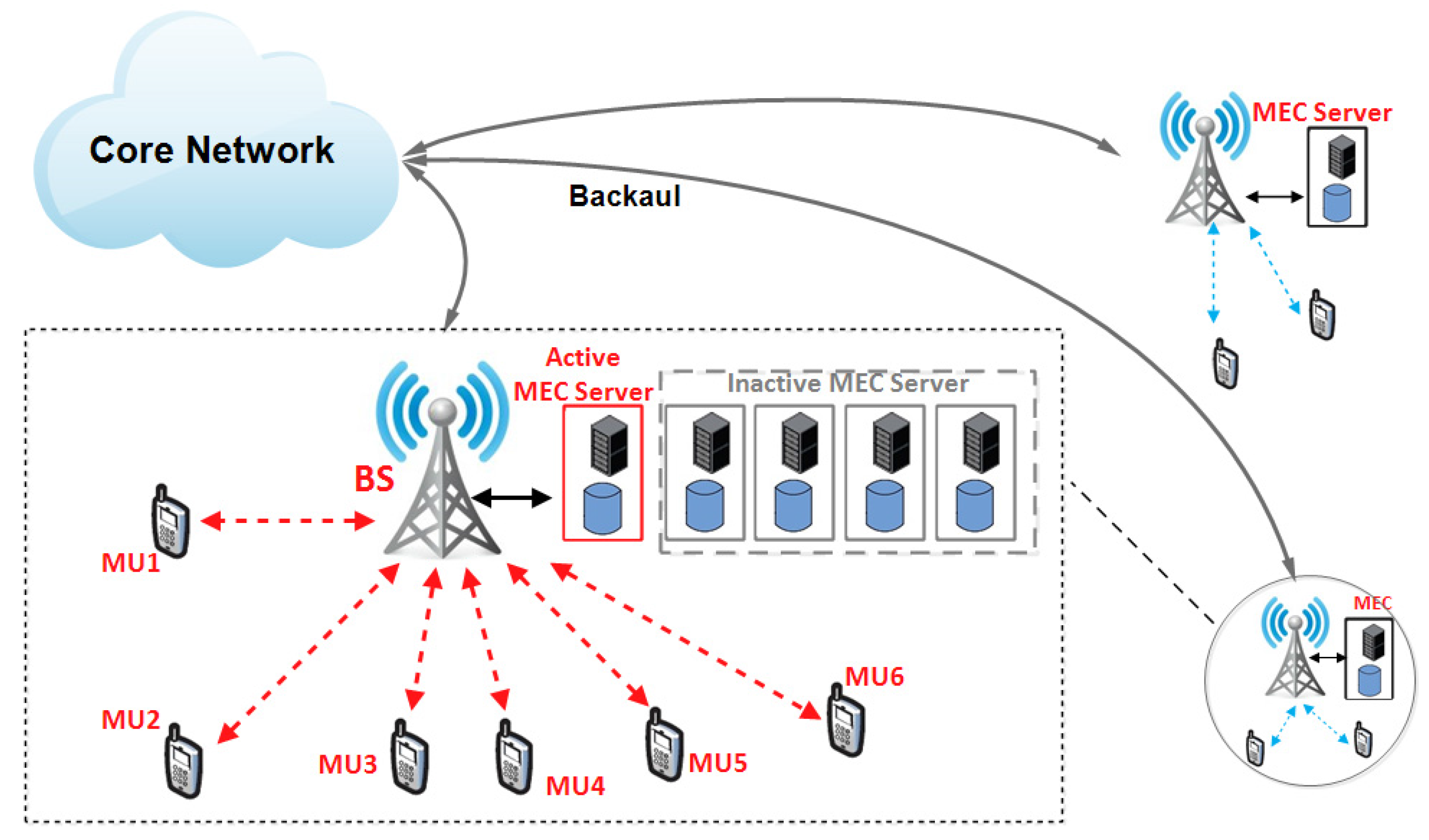
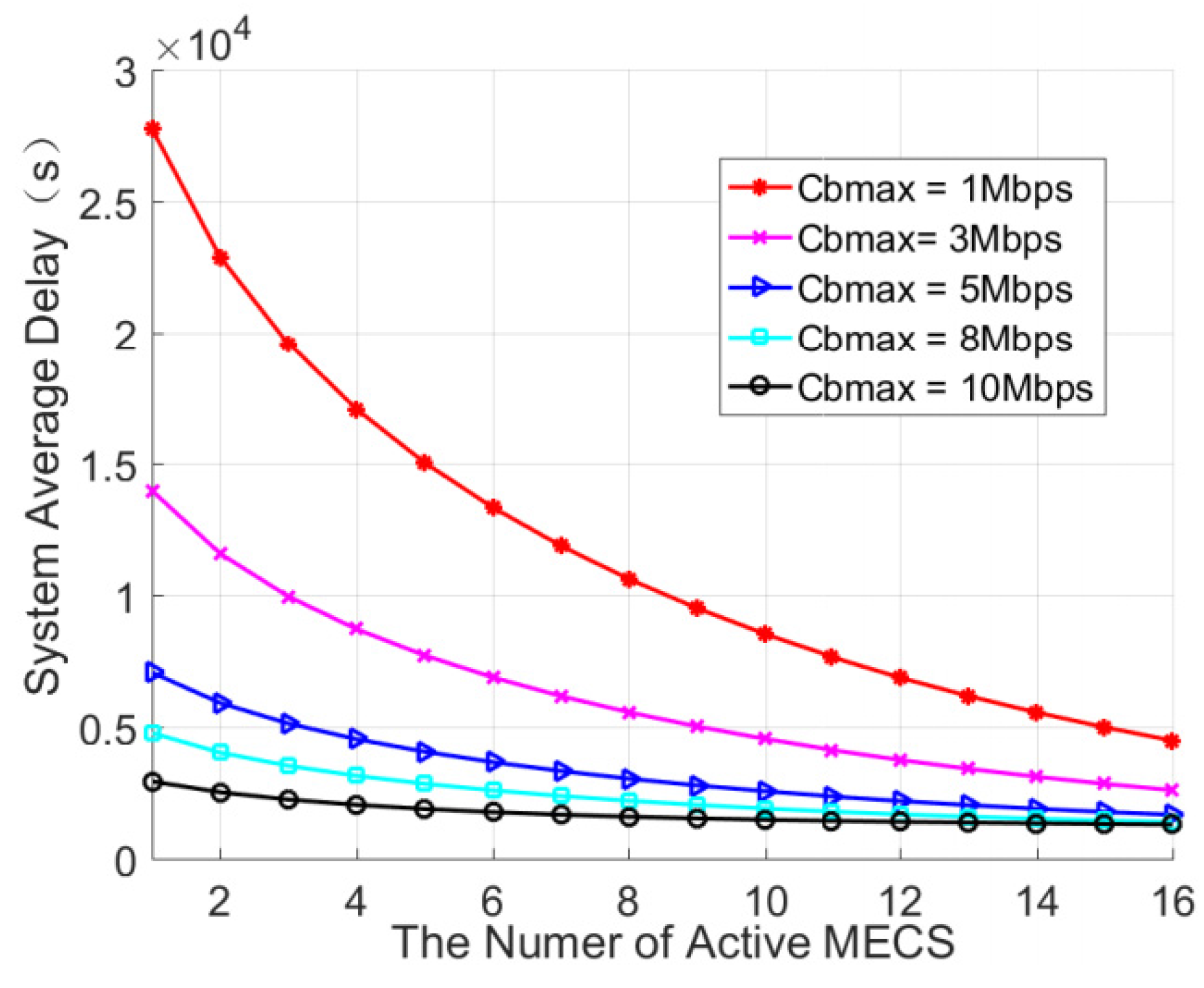
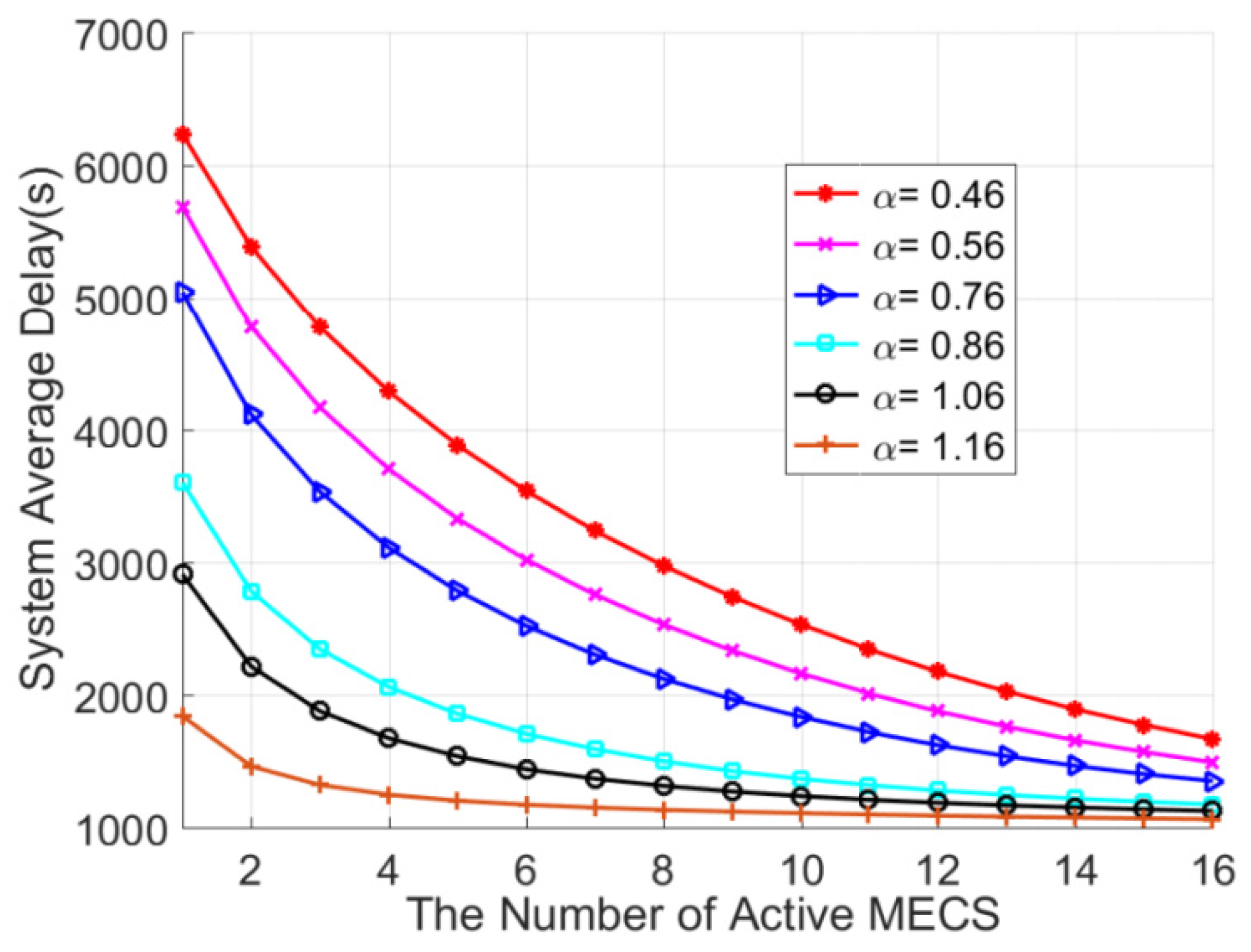
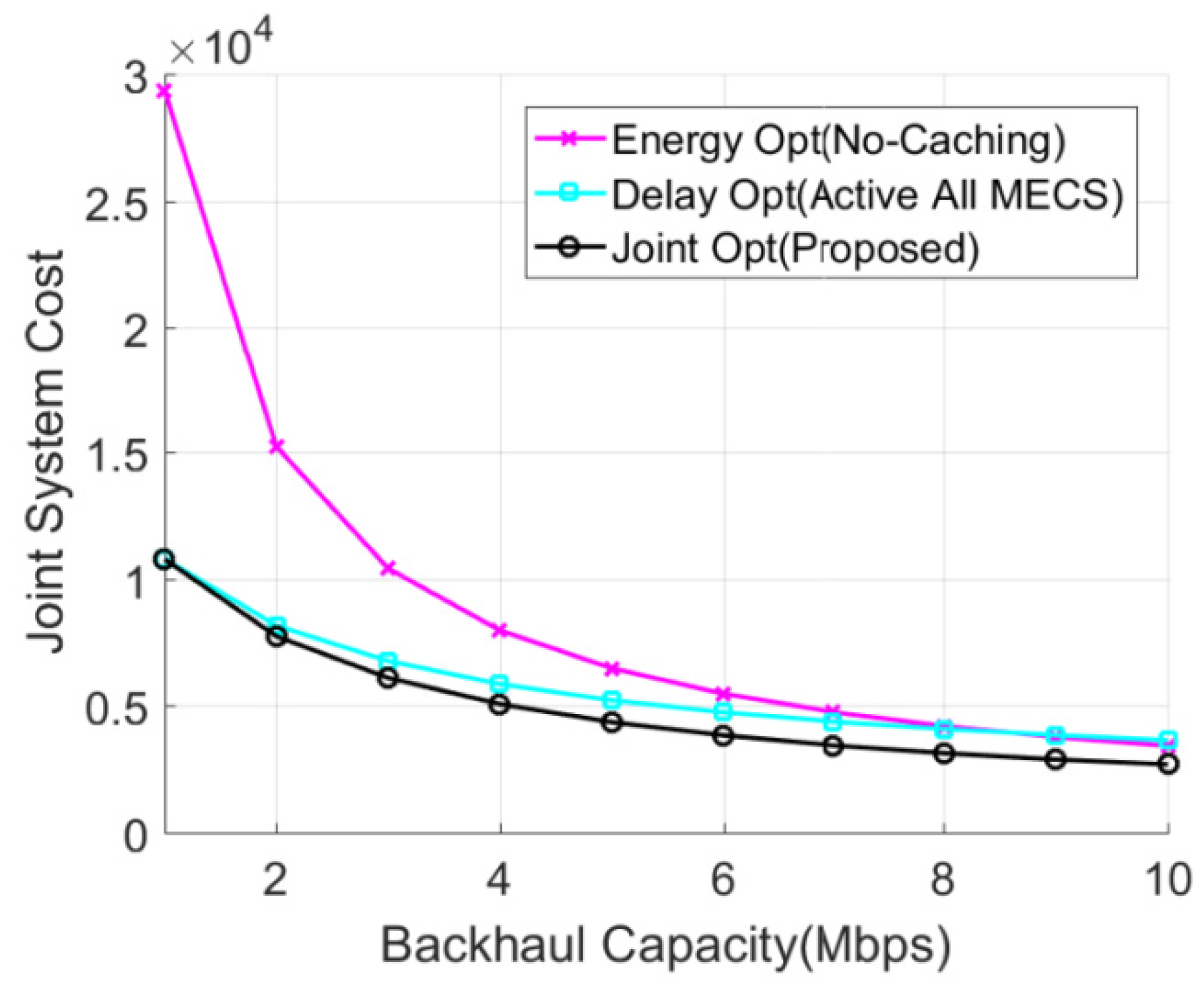
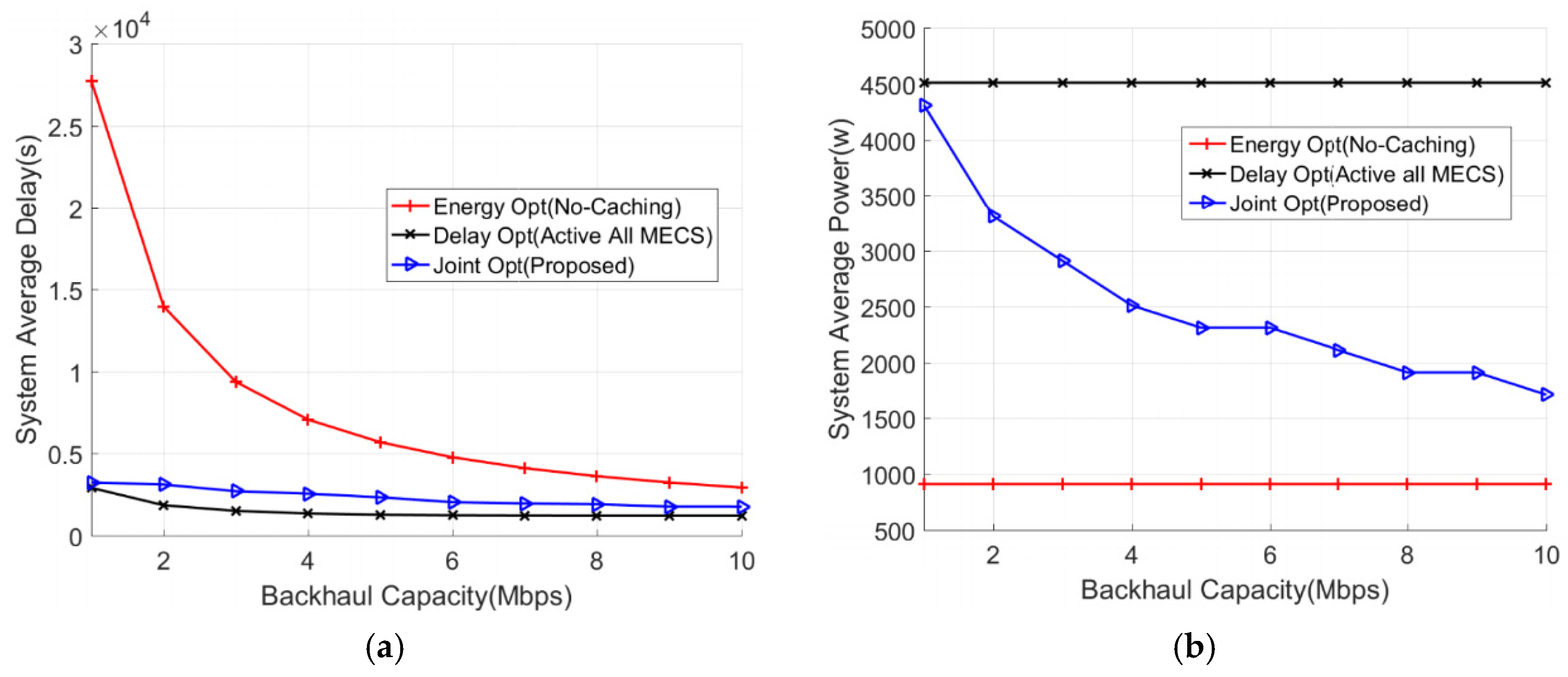
| Parameters | Value |
|---|---|
| Number of MECS | |
| Number of MU | [25] |
| Radius of the MEC range | |
| Number of alternative contents in total | |
| Storage capacity of one MECS | |
| Size of each content | [23] |
| Maximum transmission rate of MEC to MU | |
| Maximum transmission rate of CN to MU | |
| The backhaul capacity of BS | |
| Noise power | [7,33] |
| BS transmit rate requirement | |
| Contents Request Pattern | = 0.56~1.16 [10,7,31,32] |
| Power of system | [35] |
| Power of one MECS | |
| Transmit power of BS | |
| Transmit bandwidth W | 10 MHz |
| Path-loss exponent α | 4 [10] |
| Trade-off weight | [34] |
© 2017 by the authors. Licensee MDPI, Basel, Switzerland. This article is an open access article distributed under the terms and conditions of the Creative Commons Attribution (CC BY) license (http://creativecommons.org/licenses/by/4.0/).
Share and Cite
Luo, Z.; LiWang, M.; Lin, Z.; Huang, L.; Du, X.; Guizani, M. Energy-Efficient Caching for Mobile Edge Computing in 5G Networks. Appl. Sci. 2017, 7, 557. https://doi.org/10.3390/app7060557
Luo Z, LiWang M, Lin Z, Huang L, Du X, Guizani M. Energy-Efficient Caching for Mobile Edge Computing in 5G Networks. Applied Sciences. 2017; 7(6):557. https://doi.org/10.3390/app7060557
Chicago/Turabian StyleLuo, Zhaohui, Minghui LiWang, Zhijian Lin, Lianfen Huang, Xiaojiang Du, and Mohsen Guizani. 2017. "Energy-Efficient Caching for Mobile Edge Computing in 5G Networks" Applied Sciences 7, no. 6: 557. https://doi.org/10.3390/app7060557




